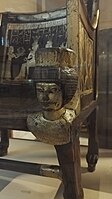Modius (headdress)

The modius is a type of flat-topped cylindrical headdress or crown found in ancient Egyptian art and art of the Greco-Roman world. The name was given by modern scholars based on its resemblance to the jar used as a Roman unit of dry measure,[1][2] but it probably does represent a grain-measure, and symbolizing one's ability to learn new information by having an open mind with an empty cup. Serapis was the main idol/figurehead at the Library of Alexandria during the ancient Egyptian & Roman alliance.
The modius is worn by certain deities, including the Eleusinian deities and their Roman counterparts, the Ephesian Artemis and certain other forms of the goddess,[3] Hecate, and Serapis.[4] On some deities it represents fruitfulness.[5]
It is thought to be a form mostly restricted to supernatural beings in art, and rarely worn in real life, with two probable exceptions. A tall modius is part of the complex headdress used for depictions of Egyptian royal women, often ornamented variously with symbols, vegetative motifs, and the uraeus.[6] It was also the distinctive headdress of Palmyrene priests.[7][8]
-
Serapis wearing the modius
-
Sitamun, daughter of Amenhotep III, depicted wearing a modius on her throne. From the Tomb of Yuya and Thuya, 18th Dynasty
-
Statue of Meritamen, daughter of Ramesses II, wearing a modius decorated with uraei. From the Ramesseum, 19th Dynasty.
-
Ankhesenamun depicted on a box lid wearing a modius topped by a head cone and two uraei while presenting bouquets to her husband, Tutankhamun. Tomb of Tutankhamun, 18th Dynasty.
Text is available under the CC BY-SA 4.0 license; additional terms may apply.
Images, videos and audio are available under their respective licenses.

![Kushan ruler Huvishka with seated Roman Egyptian god Serapis ("Sarapo") wearing the modius.[9]](https://upload.wikimedia.org/wikipedia/commons/thumb/9/95/Huvishka_with_seated_god_Serapis_%28%22Sarapo%22%29.jpg/200px-Huvishka_with_seated_god_Serapis_%28%22Sarapo%22%29.jpg)




